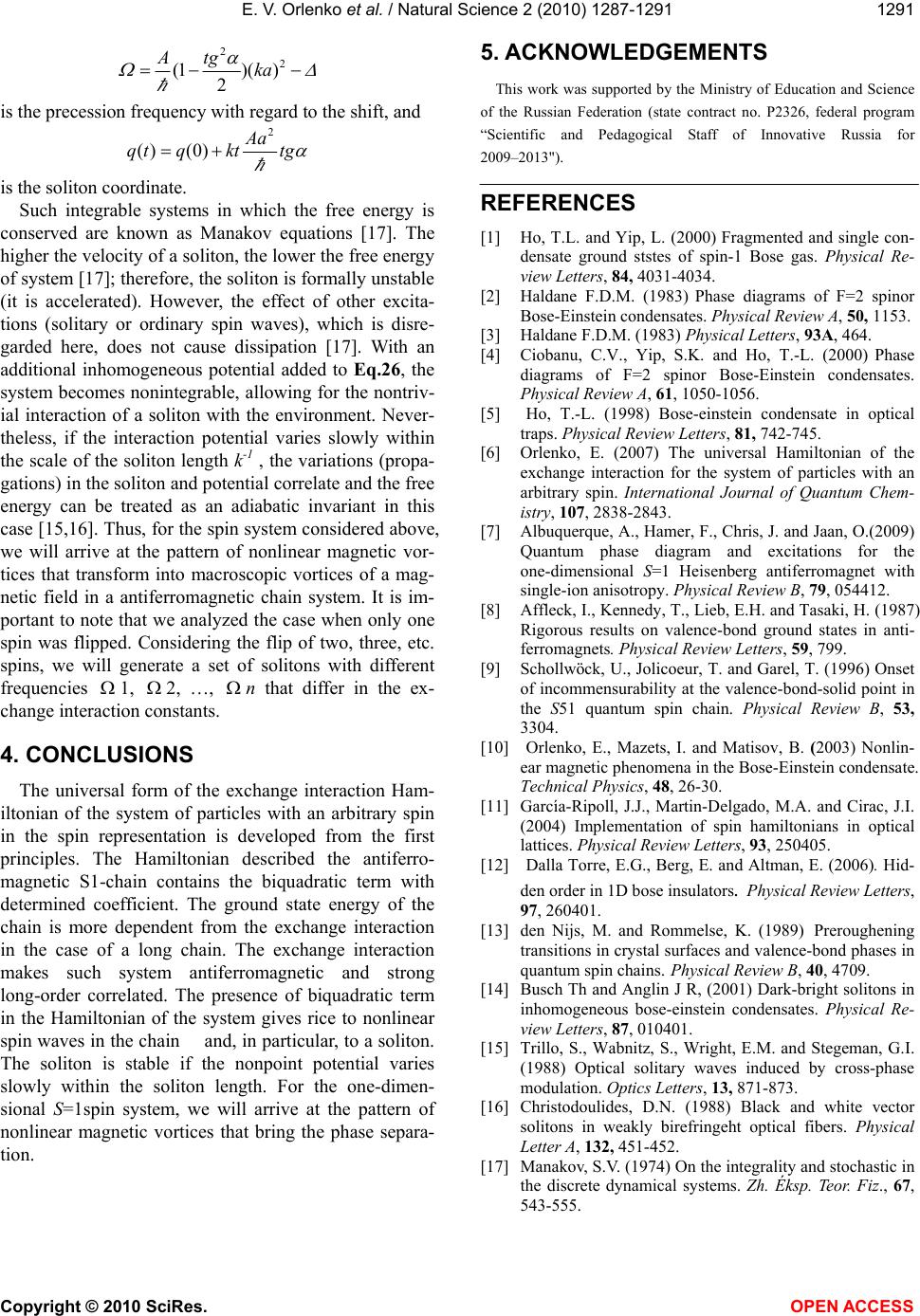
E. V. Orlenko et al. / Natural Science 2 (2010) 1287-1291
Copyright © 2010 SciRes. OPEN ACCESS
1291
2
2
(1)()
2
Atgka
is the precession frequency with regard to the shift, and
2
() (0)Aa
qt qkttg
is the soliton coordinate.
Such integrable systems in which the free energy is
conserved are known as Manakov equations [17]. The
higher the velocity of a soliton, the lower the free energy
of system [17]; therefore, the soliton is formally unstable
(it is accelerated). However, the effect of other excita-
tions (solitary or ordinary spin waves), which is disre-
garded here, does not cause dissipation [17]. With an
additional inhomogeneous potential added to Eq.26, the
system becomes nonintegrable, allowing for the nontriv-
ial interaction of a soliton with the environment. Never-
theless, if the interaction potential varies slowly within
the scale of the soliton length k-1 , the variations (propa-
gations) in the soliton and potential correlate and the free
energy can be treated as an adiabatic invariant in this
case [15,16]. Thus, for the spin system considered above,
we will arrive at the pattern of nonlinear magnetic vor-
tices that transform into macroscopic vortices of a mag-
netic field in a antiferromagnetic chain system. It is im-
portant to note that we analyzed the case when only one
spin was flipped. Considering the flip of two, three, etc.
spins, we will generate a set of solitons with different
frequencies 1, 2, …,
n that differ in the ex-
change interaction constants.
4. CONCLUSIONS
The universal form of the exchange interaction Ham-
iltonian of the system of particles with an arbitrary spin
in the spin representation is developed from the first
principles. The Hamiltonian described the antiferro-
magnetic S1-chain contains the biquadratic term with
determined coefficient. The ground state energy of the
chain is more dependent from the exchange interaction
in the case of a long chain. The exchange interaction
makes such system antiferromagnetic and strong
long-order correlated. The presence of biquadratic term
in the Hamiltonian of the system gives rice to nonlinear
spin waves in the chain and, in particular, to a soliton.
The soliton is stable if the nonpoint potential varies
slowly within the soliton length. For the one-dimen-
sional S=1spin system, we will arrive at the pattern of
nonlinear magnetic vortices that bring the phase separa-
tion.
5. ACKNOWLEDGEMENTS
This work was supported by the Ministry of Education and Science
of the Russian Federation (state contract no. P2326, federal program
“Scientific and Pedagogical Staff of Innovative Russia for
2009–2013").
REFERENCES
[1] Ho, T.L. and Yip, L. (2000) Fragmented and single con-
densate ground ststes of spin-1 Bose gas. Physical Re-
view Letters, 84, 4031-4034.
[2] Haldane F.D.M. (1983) Phase diagrams of F=2 spinor
Bose-Einstein condensates. Physical Review A, 50, 1153.
[3] Haldane F.D.M. (1983) Physical Letters, 93A, 464.
[4] Ciobanu, C.V., Yip, S.K. and Ho, T.-L. (2000) Phase
diagrams of F=2 spinor Bose-Einstein condensates.
Physical Review A, 61, 1050-1056.
[5] Ho, T.-L. (1998) Bose-einstein condensate in optical
traps. Physical Review Letters, 81, 742-745.
[6] Orlenko, E. (2007) The universal Hamiltonian of the
exchange interaction for the system of particles with an
arbitrary spin. International Journal of Quantum Chem-
istry, 107, 2838-2843.
[7] Albuquerque, A., Hamer, F., Chris, J. and Jaan, O.(2009)
Quantum phase diagram and excitations for the
one-dimensional S=1 Heisenberg antiferromagnet with
single-ion anisotropy. Physical Review B, 79, 054412.
[8] Affleck, I., Kennedy, T., Lieb, E.H. and Tasaki, H. (1987)
Rigorous results on valence-bond ground states in anti-
ferromagnets. Physical Review Letters, 59, 799.
[9] Schollwöck, U., Jolicoeur, T. and Garel, T. (1996) Onset
of incommensurability at the valence-bond-solid point in
the S51 quantum spin chain. Physical Review B, 53,
3304.
[10] Orlenko, E., Mazets, I. and Matisov, B. (2003) Nonlin-
ear magnetic phenomena in the Bose-Einstein condensate.
Technical Physics, 48, 26-30.
[11] García-Ripoll, J.J., Martin-Delgado, M.A. and Cirac, J.I.
(2004) Implementation of spin hamiltonians in optical
lattices. Physical Review Letters, 93, 250405.
[12] Dalla Torre, E.G., Berg, E. and Altman, E. (2006). Hid-
den order in 1D bose insulators. Physical Review Letters,
97, 260401.
[13] den Nijs, M. and Rommelse, K. (1989) Preroughening
transitions in crystal surfaces and valence-bond phases in
quantum spin chains. Physical Review B, 40, 4709.
[14] Busch Th and Anglin J R, (2001) Dark-bright solitons in
inhomogeneous bose-einstein condensates. Physical Re-
view Letters, 87, 010401.
[15] Trillo, S., Wabnitz, S., Wright, E.M. and Stegeman, G.I.
(1988) Optical solitary waves induced by cross-phase
modulation. Optics Letters, 13, 871-873.
[16] Christodoulides, D.N. (1988) Black and white vector
solitons in weakly birefringeht optical fibers. Physical
Letter A, 132, 451-452.
[17] Manakov, S.V. (1974) On the integrality and stochastic in
the discrete dynamical systems. Zh. Éksp. Teor. Fiz., 67,
543-555.